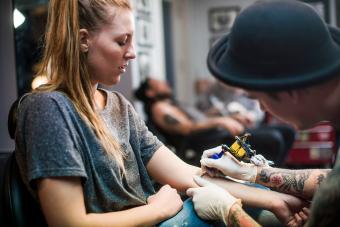
A tattoo infection is not something people really want to contemplate when they're enthusiastically regarding a new body ink design. However, infections can happen whether you want to think about them or not. Learn more about the risks so you can better protect yourself.
Types of Tattoo Infection
Skin Infections
Skin infections are relatively common after getting a tattoo. They can be caused by a variety of reasons, including:
- Unsterilized equipment and a lack of sterile conditions in the immediate tattoo environment
- Transmission from the artist creating the tat if he or she doesn't take precautions with personal hygiene
- The use of tattoo ink that has been contaminated, something that the FDA issued warnings about during the summer of 2012
- Failure to diligently follow aftercare instructions to keep the fresh site clean and moisturized during the healing process

Tattooing creates thousands of tiny puncture wounds in your skin as the ink is delivered beneath the outer layers. Your skin is your first line of defense against bacterial invasion, so poking holes in it is like opening a door and inviting germs in. Remember that your new tattoo is an open wound, and it can become infected like any cut that is not cared for properly.
Watch closely for symptoms of an infected tattoo. If you see any signs of infection with a fresh tattoo, a visit to the doctor is in short order. Most infections are easily treated with an antibiotic and resuming aftercare procedures. However, significant infections can result in blood poisoning if they are allowed to progress for too long.
Hepatitis C
Tattoo enthusiasts may also contract a hepatitis C infection, a deadly blood disease that attacks liver function. The disease is typically transferred from one person to another when proper sterile procedures aren't followed. This can include reusing needles between clients and reusing inks. In fact, a study conducted by a researcher at UT Southwestern Medical Center found that tattoos cause as many as 41 percent of all cases of hepatitis C.
There is no known cure for hepatitis C, and the disease can be fatal unless it goes into remission. Even then, stress and other illnesses can trigger its renewed attack on the liver, leading to eventual death.
HIV
The Centers for Disease Control (CDC) affirms there have been no reported cases of HIV infections from tattoos. But tattooing involves piercing your skin, so precautions are important. Licensed tattoo artists and shops are required to use autoclave sterilization, protective gloves and masks, and unused or sterilized needles and new ink for each customer. Requesting new needles is perfectly fine. Always check your tattoo parlor's license and ask them to show you the sterilization equipment and procedure. A licensed artist and shop will be happy to do that - they want you to stay safe as much as you do. Shared ink and insufficiently sterilized or reused equipment can spread HIV contamination. This is one case in which using an unlicensed freelancer isn't a good idea.
Comparing Normal Healing and an Infection
Most tattoos look at least a little irritated right after being completed, though the initial irritation should begin to subside in a few days as the needle punctures heal.
According to University of Michigan Health Services, it's normal to experience the following symptoms for a few weeks while your tattoo is healing:
- Itching
- Scabbing
- Flaking
These signs are healthy. The scabbing and crust shouldn't be picked at or scraped off. The crust helps seal the skin from outside organisms that can cause infection, so it's a good thing.
If you notice any other symptoms during the healing process or if redness lasts longer than it should, there's a chance your tat is becoming infected. If this happens, seek help from a medical professional immediately.
Protecting Yourself from Tattoo Infections
You can significantly lower your risk of getting a tattoo infection by doing a little research beforehand and thoroughly checking out both the shop and the artist you intend to use. Safety tips suggested by the Eastern Ontario Health Unit include:

- Familiarize yourself with basic sterile procedures to be followed when creating tattoos.
- Take a look around the shop to make sure they have an autoclave and that they are using it.
- Watch your artist to make sure he or she properly disinfects before donning disposable plastic gloves and a surgical mask.
- Follow all aftercare instructions to the letter.
You may even want to insist your artist uses a brand new needle rather than one that has been run through an autoclave. Although a properly operated autoclave forces sterilizing steam through very tiny spaces, there's still a chance that a pocket of infection could survive in the hollow.
Stay Aware
A tattoo infection definitely isn't comfortable, and it can ruin your brand new body art if scarring takes place. A moderate level of awareness on your part, and a great deal of care on your artist's part can ensure you never experience a tattoo infection of any magnitude.







